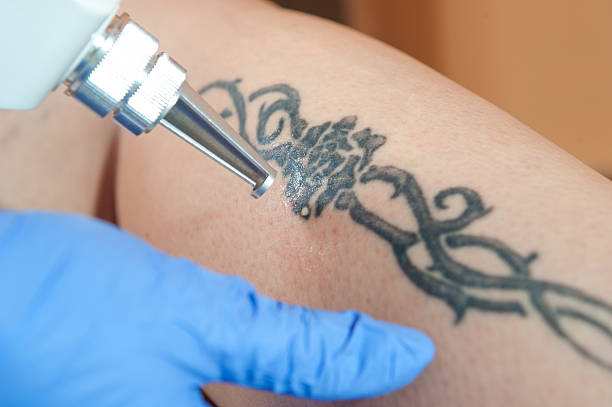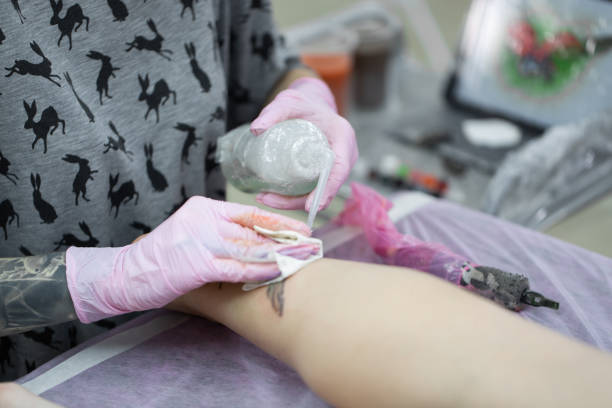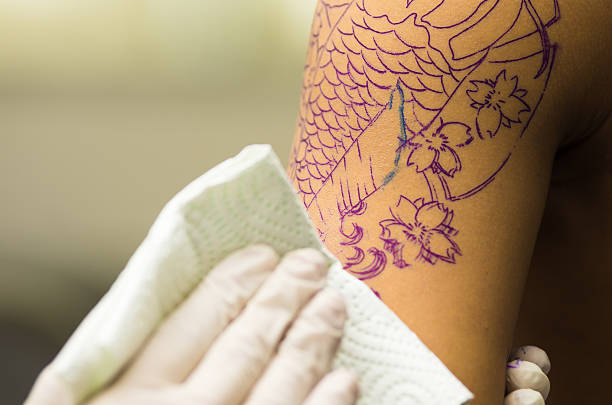Getting a new tattoo is an exciting experience. It’s a form of self-expression, an art, and a part of your identity etched into your skin. But the days following your tattoo session are just as important as the ink itself.
One common part of the healing process that raises questions and concerns is tattoo scabbing. Is it normal? How should you deal with scabs? Can you prevent scabbing altogether?
This guide will walk you through everything you need to know about tattoo scabbing, including causes, prevention tips, and best practices for managing scabs if they occur.

What Is Tattoo Scabbing? And why does it happen?
Tattoo scabbing is a natural part of your body’s healing process after getting tattooed. When the tattoo artist injects ink into your dermis, small wounds are created in your skin, triggering your body’s healing response. Scabs form as your skin repairs these micro-injuries.
While light scabbing is completely normal and to be expected, heavier scabbing may signal improper aftercare or excessive trauma to the skin.
Tattoos heal differently for every individual, but the goal is to achieve smooth and minimal scabbing for the best results.
Key Points:
- Normal scabbing: Thin, light flakes forming over your tattoo.
- Problematic scabbing: thick, heavy scabs; cracking scabs; or scabs with signs of infection, such as redness, pus, or an odor.
Also Visit : Laser Treatment: Painless Method To Become Beautiful
What Causes Tattoo Scabbing?
Some scabbing is unavoidable, but excessive scabbing can often be traced back to specific causes. Here are the most common culprits:
- Improper Aftercare
Skipping or overdoing the cleaning routine can delay healing. Harsh scrubbing or neglecting to wash the tattoo properly can cause irritation and additional scabbing.
- Dry Skin
Tattoos need to be kept moisturized. Failing to apply a recommended tattoo balm or moisturizer frequently enough can cause skin to crack and scab.
- Tight Clothing
Clothing that rubs against the tattoo can irritate the area and lead to heavier scabbing. Opt for loose-fitting garments, especially during the first stages of healing.
- Scratching or Picking
Picking at tattoo scabs is a big no-no. It can peel away fresh layers of healing skin and even pull out ink, resulting in uneven coloring.
- Over-Moisturizing
Applying too much cream can over-saturate scabs, softening them to the point of detachment. This could result in problems such as tattoo scabs peeling off during the cream application process.

Avoiding these mistakes
How to Prevent Tattoo Scabbing
While some degree of scabbing is natural, proper care can minimize its severity and ensure your tattoo heals beautifully.
- Follow Your Artist’s Aftercare Instructions
Your tattoo artist knows best. If they recommend a specific cleaning or moisturizing schedule, stick to it diligently.
- Clean Gently
Wash your tattoo twice daily with fragrance-free soap and lukewarm water. Pat (don’t rub) it dry with a clean, soft towel.
- Moisturize Appropriately
Use a tattoo-safe balm to keep the area moisturized but not overly saturated. When asked, “Should you moisturize tattoo scabs?” The answer is yes—but evenly and sparingly to avoid issues like heavy scabbing or cracking.
- Hands Off!
Resist the urge to scratch or pick at scabs. As tempting as it may be, disturbing the scabs can lead to ink loss, scarring, and infection.
- Wear Loose Clothing
Tight fabric that constantly rubs against the tattoo can irritate the area. Opt for breathable, loose-fitting clothes during the healing phase.
- Avoid Harsh Environments
Stay away from pools, hot tubs, direct sunlight, and any overly humid or dirty settings that could irritate or infect your fresh tattoo.

How to Deal With Scabbing on Your Tattoo
If scabbing does occur, don’t panic. Here’s how to care for your tattoo and ensure a smooth recovery:
- Gently Cleanse the Area
Clean your tattoo twice daily using lukewarm water and a gentle, fragrance-free soap.
- Moisturize Regularly
Apply a thin layer of tattoo-safe moisturizer to help soften the scabs and keep your skin hydrated. Avoid heavy creams, like Vaseline, as they can prevent airflow and delay healing.
- Prevent Scab Cracking
Cracked scabs can pull at the skin and damage your tattoo. Applying moisturizer evenly helps keep scabs from cracking or lifting too soon.
- Be Patient
Light scabbing is temporary and will usually peel off naturally within a week or two. Avoid any attempts to speed up the process through picking or scratching.

How to Deal with Scabbing After a Week
If scabbing persists beyond the first week, continue following your aftercare routine and monitor the area for changes. Thick or heavily bleeding scabs may require a consultation with your tattoo artist or dermatologist.
When to Seek Professional Help
Sometimes, tattoo scabbing can go beyond normal healing. Here’s when it’s time to seek help from your tattoo artist or a dermatologist:
- Persistent Redness or Swelling
Mild redness is normal in the first few days, but if it worsens instead of improving, it could be a sign of infection.
Pus or an unusual smell often accompanies infections. Don’t ignore these signs.
This may indicate that your tattoo isn’t healing properly or is being irritated by external factors.
- Tattoo Scab Came Off & No Ink Underneath
If you notice missing ink spots, consult your artist about possible touch-ups once your tattoo finishes healing.
Your tattoo artist is usually your first point of contact for advice about the healing process. For serious symptoms, a dermatologist can provide medical treatment if needed.

FAQs About Tattoo Scabbing
Is it normal for my tattoo to scab?
Yes, light scabbing is perfectly normal and part of the healing process.
Do you moisturize scabbing tattoos?
Yes, moisturizing is essential for healing, but avoid over-saturating the area.
Is Vaseline good for scabbing tattoos?
No, Vaseline creates a non-breathable barrier that can trap moisture and delay healing. Opt for tattoo-safe balms instead.
What should I do if my tattoo doesn’t peel?
Not all tattoos peel visibly. If your tattoo looks clean and shows no signs of infection, it’s likely healing normally.
What should I do if my tattoo scabs come off too early?
Avoid picking at the newly exposed skin, keep it clean, and apply moisturizer. If ink loss occurs, consult your artist.
Conclusion: Tattoo Means Caring for Yourself
A tattoo is an investment in self-expression, and proper aftercare ensures your art looks vibrant for years to come. By understanding and minimizing tattoo scabbing, you’re taking the first step toward a safe and clean healing process. Remember, the better you care for your tattoo, the better it cares for you.
For more tattoo aftercare tips or expert advice, bookmark this page or explore our website for additional resources.